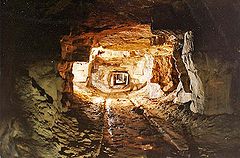(Redirected from
Great Oolite Formation)
| Great Oolite Group | |
|---|---|
| Stratigraphic range: | |
 The
Combe Down and Bathampton Down Mines, where the Great Oolite Group can be found | |
| Type | Group |
| Sub-units | Cornbrash Formation, Chipping Norton Limestone, Sharp's Hill Formation, Taynton Limestone Formation, Forest Marble Formation, Hampen Formation, White Limestone Formation, Rutland Formation, Blisworth Limestone, Blisworth Clay Formation, Chalfield Oolite Formation, Corsham Limestone Formation, Athelstan Oolite Formation, Horsehay Sand Formation, Tresham Rock Formation |
| Underlies | Ancholme Group |
| Overlies | Inferior Oolite Group |
| Thickness | 22–200 m (72–656 ft) (224 m (735 ft) offshore) |
| Lithology | |
| Primary | Limestone, Mudstone |
| Other | Sandstone |
| Location | |
| Region | Europe |
| Country | |
| Extent | Dorset to Norfolk |
| Type section | |
| Named for | Oolite |
The Great Oolite Group is a Middle Jurassic stratigraphic unit that outcrops in southern England. It consists of a complex set of marine deposits primarily mudstone and bioclastic ooidal and fine grained limestone, deposited in nearshore to shelf settings. [1] It is exposed at the surface as a variably thick belt extending roughly NE-SW from the coast of Dorset up to the Humber. It is also present at depth in the Weald and Wessex Basins, as well as offshore. Several of the constituent formations, notably the Taynton Limestone Formation and the Forest Marble Formation are notable for their fossil content, including those of dinosaurs and pterosaurs and some of the earliest mammals.
Paleofauna
- Cardiodon rugulosus
- Cetiosaurus oxoniensis
- Dromaeosauridae indet.
- Eoplophysis vetustus (stegosaurid indet)
- Megalosaurus bucklandii
- Proceratosaurus bradleyi
- Seldsienean megistorhynchus
See also
References
- ^ "Great Oolite Group". The BGS Lexicon of Named Rock Units. British Geological Survey. Retrieved 31 May 2014.
Bibliography
- Weishampel, David B.; Dodson, Peter; and Osmólska, Halszka (eds.): The Dinosauria, 2nd, Berkeley: University of California Press. 861 pp. ISBN 0-520-24209-2.